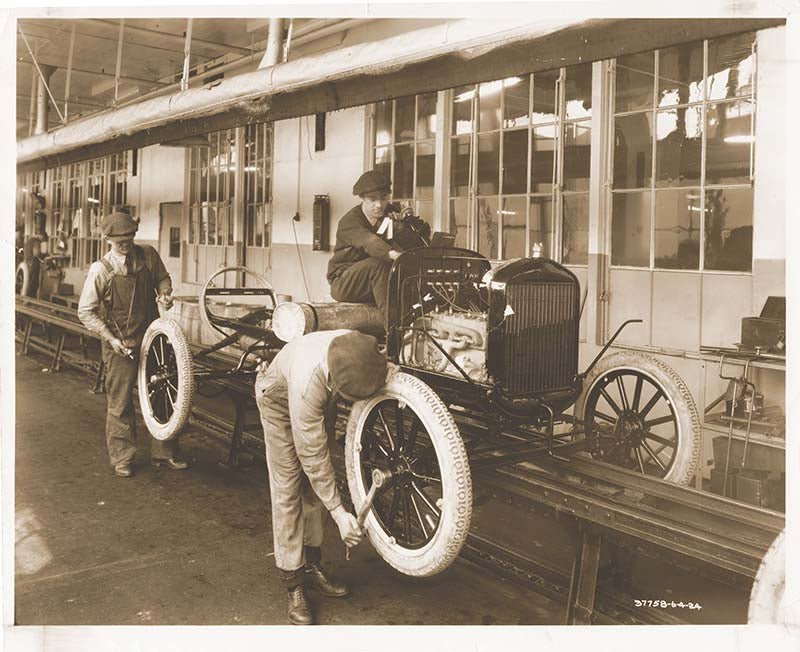
Detroit Car Manufacturing - A Brief History
The Paris of the midwest has a long and complicated history, but it is one that can’t be explained without giving a bulk of the credit and notoriety to the massive car manufacturing history that took place from the beginning of the automotive revolution through to today. The city of Detroit is known for being the birthplace of the Model T - which is often credited with being the first mass produced car in the united states, giving Detroit a leg up in the automotive manufacturing race from the beginning.
Contrary to popular belief, Henry Ford wasn't the first person to put Detroit on the map. According to historic records, the city was officially founded in 1701 by Antoine de la mothe Cadillac, a French military leader during the time of the French command of Fort Michilimackinac. Through the years and the many ups and downs that followed, Detroit has since grown to be the largest city in the Midwest, making it the perfect size to host Ford, General Motors, and Chrysler’s automotive manufacturing operations - or as most people know them today - the Big Three.
Ford Motor Co. was founded almost 200 years after the city’s birth in 1903. It followed closely behind Henry Ford’s first automobile test drive through the city streets in 1896 (which we can only imagine turned some serious heads during this time) and his later first and second failed attempts at developing his namesake’s manufacturing company. With the introduction of the Model T in 1903, Ford Motor Co. ramped up into full force production mode until almost 10 years later when Ford moved his operations to Dearborn, MI, where they haven’t produced vehicles since.


One of the many business partners and investors of Ford Motor Co. were John and Horace Dodge, two brothers who went on to develop and run Dodge Brothers Manufacturing beginning in 1915. Fast forward to today, many Dodge vehicles are still produced in the “Dodge Main” plant in Hamtramck, MI, a city just outside of Detroit proper. The company proudly promotes its American Muscle vehicles, and we’re pretty proud as a city to be able to say we’ve known them from the beginning.


Shop our licensed Dodge gear here
Following the grand opening of Ford, William Durant and Charles Stewart Mott founded General Motors (GM) in Flint, MI in 1908, but is currently the only U.S. automaker with headquarters in the heart of Detroit in the iconic Renaissance Center, which was obtained by GM in 1996. Finally, in 1926, Walter Chrsyler helped develop the Chrysler Corporation in Detroit and for many years it stood as the third largest of the Big Three manufacturers in the United States. Chrysler Corp. then went on to rapidly expand their company as well as their product line with the purchase of Dodge Brothers, Inc. in the summer of 1928 and the introduction of Plymouth that same year.


Not long after these change makers started to sink their teeth into the booming auto industry, the Great Depression swept through the country and took many of the jobs and thriving industries with it. In just a short span of three years from 1929-1932, the automotive production in both Canada and the United States plummeted from 5.6 million vehicles to only 1.4 million vehicles. That said, surprisingly, the lower-priced automotive segments grew from 40% of total automotive sales in the United States 1929 to 80% of sales in 1933. The performance of Chrysler and GM during the 1930s stands out to most during this time - in fact, General Motors was profitable during every year of the Great Depression, and Chrysler only experienced financial loss during one year.
I think Detroit is where muscle meets brains.
Just as things were ramping up again for the auto industry, the oil crisis in 1973 forced many of the people who owned vehicles or those with purchasing power to set their sights on much smaller European and Japanese-made cars, since they consumed far less oil than the four-door American muscle car. The crisis forced the Big 3 to hit the brakes on manufacturing due to severely decreased demand from the consumer as well as extreme rising prices in the market. Not even Detroit’s superstars were immune to this drop in demand, which caused yet another dramatic decrease in revenue and a loss in jobs for the city.
It is fair to say that Detroit’s long and complicated history with its automotive hub is anything but boring or subtle. For a city that is known for its obstacles and ability to overcome, adapt, and start again, it makes perfect sense that the Big Three are still alive and well in the heart of the city today. From slow beginnings to rampant bursts of genius, collaboration, to the future of manufacturing, the Spirit of Detroit is alive and well in the cars and corporations that make the city great to this day. In true form, Detroit is a melting pot of people, cultures, ideas, muscle, grease, and a whole lot of heart. It is the place where muscle meets brains, and we wouldn’t want it any other way.


Leave a comment